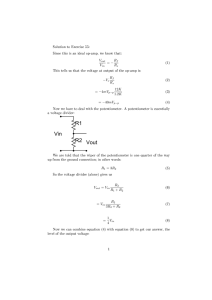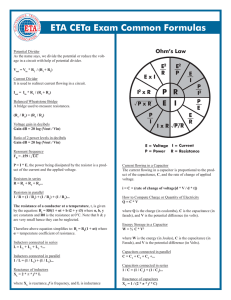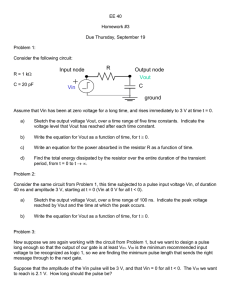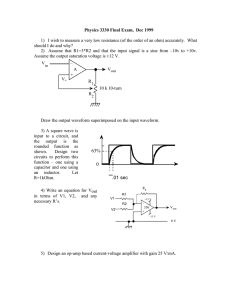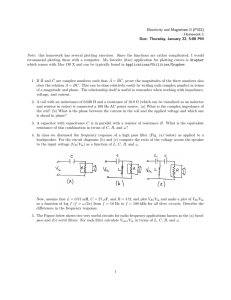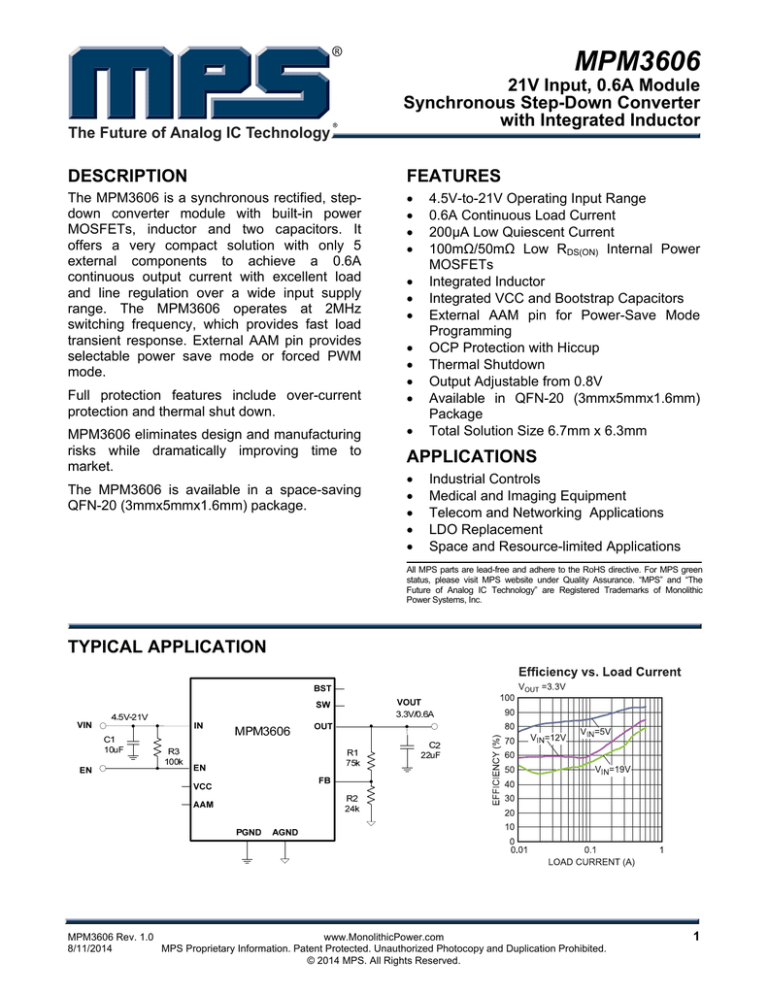
MPM3606
The Future of Analog IC Technology
21V Input, 0.6A Module
Synchronous Step-Down Converter
with Integrated Inductor
DESCRIPTION
FEATURES
The MPM3606 is a synchronous rectified, stepdown converter module with built-in power
MOSFETs, inductor and two capacitors. It
offers a very compact solution with only 5
external components to achieve a 0.6A
continuous output current with excellent load
and line regulation over a wide input supply
range. The MPM3606 operates at 2MHz
switching frequency, which provides fast load
transient response. External AAM pin provides
selectable power save mode or forced PWM
mode.
Full protection features include over-current
protection and thermal shut down.
MPM3606 eliminates design and manufacturing
risks while dramatically improving time to
market.
The MPM3606 is available in a space-saving
QFN-20 (3mmx5mmx1.6mm) package.
4.5V-to-21V Operating Input Range
0.6A Continuous Load Current
200μA Low Quiescent Current
100mΩ/50mΩ Low RDS(ON) Internal Power
MOSFETs
Integrated Inductor
Integrated VCC and Bootstrap Capacitors
External AAM pin for Power-Save Mode
Programming
OCP Protection with Hiccup
Thermal Shutdown
Output Adjustable from 0.8V
Available in QFN-20 (3mmx5mmx1.6mm)
Package
Total Solution Size 6.7mm x 6.3mm
APPLICATIONS
Industrial Controls
Medical and Imaging Equipment
Telecom and Networking Applications
LDO Replacement
Space and Resource-limited Applications
All MPS parts are lead-free and adhere to the RoHS directive. For MPS green
status, please visit MPS website under Quality Assurance. “MPS” and “The
Future of Analog IC Technology” are Registered Trademarks of Monolithic
Power Systems, Inc.
TYPICAL APPLICATION
MPM3606 Rev. 1.0
www.MonolithicPower.com
8/11/2014
MPS Proprietary Information. Patent Protected. Unauthorized Photocopy and Duplication Prohibited.
© 2014 MPS. All Rights Reserved.
1
MPM3606 – SYNCHRONOUS STEP-DOWN MODULE WITH INTEGRATED INDUCTOR
ORDERING INFORMATION
Part Number*
Package
MPM3606GQV
QFN-20 (3mmx5mmx1.6mm)
Top Marking
MP3606
M
* For Tape & Reel, add suffix –Z (e.g. MPM3606GQV–Z)
PACKAGE REFERENCE
ABSOLUTE MAXIMUM RATINGS (1)
Thermal Resistance
VIN ..................................................-0.3V to 28V
VSW ......................................................................
-0.3V (-5V for <10ns) to 28V (30V for <10ns)
VBST ........................................................ VSW+6V
All Other Pins ................................-0.3V to 6V (2)
(3)
Continuous Power Dissipation (TA = +25°C)
............................................................. 2.7W
Junction Temperature ...............................150°C
Lead Temperature ....................................260°C
Storage Temperature................. -65°C to 150°C
QFN-20 (3mmx5mmx1.6mm) ...46 .... 10... °C/W
Recommended Operating Conditions
(4)
Supply Voltage VIN ...........................4.5V to 21V
Output Voltage VOUT ..................... 0.8V to 5.5V(5)
Operating Junction Temp. (TJ). -40°C to +125°C
(6)
θJA θJC
Notes:
1) Exceeding these ratings may damage the device.
2) About the details of EN pin’s ABS MAX rating, please refer to
page 11, Enable control section.
3) The maximum allowable power dissipation is a function of the
maximum junction temperature TJ (MAX), the junction-toambient thermal resistance θJA, and the ambient temperature
TA. The maximum allowable continuous power dissipation at
any ambient temperature is calculated by PD (MAX) = (TJ
(MAX)-TA)/θJA. Exceeding the maximum allowable power
dissipation will cause excessive die temperature, and the
regulator will go into thermal shutdown. Internal thermal
shutdown circuitry protects the device from permanent
damage.
4) The device is not guaranteed to function outside of its
operating conditions.
5) For output voltage setting above 5.5V, please refer to the
application information on page 13.
6) Measured on JESD51-7, 4-layer PCB.
MPM3606 Rev. 1.0
www.MonolithicPower.com
8/11/2014
MPS Proprietary Information. Patent Protected. Unauthorized Photocopy and Duplication Prohibited.
© 2014 MPS. All Rights Reserved.
2
MPM3606 – SYNCHRONOUS STEP-DOWN MODULE WITH INTEGRATED INDUCTOR
ELECTRICAL CHARACTERISTICS
VIN=12V, TJ=-40°C to +125°C(7), typical value is tested at TJ=+25°C, unless otherwise noted.
Parameter
Symbol
Supply Current (Shutdown)
IIN
Supply Current (Quiescent)
Iq
HS Switch-On Resistance
LS Switch-On Resistance
Inductor DC Resistance
Switch Leakage
Current Limit (8)
Oscillator Frequency
Fold-Back Frequency
Maximum Duty Cycle
Minimum On Time(8)
Condition
VFB = 1V, VAAM=0.5V
VFB = 1V, VAAM=5V
VBST-SW=5V
VCC =5V
HSRDS-ON
LSRDS-ON
LDCR
SWLKG VEN = 0V, VSW =12V
ILIMIT
Under 40% Duty Cycle
VFB=0.75V, TJ=+25°C
fSW
VFB=0.75V,TJ=-40°C to +125°C
fFB
VFB<400mV
DMAX
VFB=700mV
τON_MIN
Feedback Voltage
VFB
Feedback Current
IFB
Min
Typ
VEN = 0V,TJ=25°C
Max
Units
1
μA
0.2
0.7
100
50
60
mA
1
1.8
1700
1500
80
2.4
2000
2000
0.3
85
35
2400
2500
mΩ
mΩ
mΩ
μA
A
kHz
kHz
fSW
%
ns
TJ=+25°C
786
798
810
mV
TJ=-40°C to +125°C
782
798
814
mV
VFB=820mV
TJ=+25°C
TJ=-40°C to +125°C
5.6
4.3
10
6.2
6.2
50
6.8
7.9
nA
μA
μA
AAM Source Current
IAAM
EN Rising Threshold
VEN_RISING
1.15
1.4
1.65
V
EN Falling Threshold
VEN_FALLING
1.05
1.25
1.45
V
EN Input Current
IEN
VIN Under-Voltage Lockout
Threshold—Rising
VIN Under-Voltage Lockout
Threshold—Hysteresis
VCC Regulator
VCC Load Regulation
Soft-Start Time
Thermal Shutdown
VEN=2V
2
3.65
INUVVth
3.9
μA
4.15
V
INUVHYS
650
mV
VCC
4.9
1.5
1.5
V
%
ms
150
°C
20
°C
tSS
ICC=5mA
VOUT from 10% to 90%
(8)
Thermal Hysteresis (8)
Notes:
7) Not tested in production; guaranteed by over-temperature correlation.
8) Guaranteed by design.
MPM3606 Rev. 1.0
www.MonolithicPower.com
8/11/2014
MPS Proprietary Information. Patent Protected. Unauthorized Photocopy and Duplication Prohibited.
© 2014 MPS. All Rights Reserved.
3
MPM3606 – SYNCHRONOUS STEP-DOWN MODULE WITH INTEGRATED INDUCTOR
TYPICAL PERFORMANCE CHARACTERISTICS
Performance waveforms are captured from the evaluation board discussed in the Design
Example section.VIN = 12V, VOUT = 3.3V, TA = 25°C, unless otherwise noted.
MPM3606 Rev. 1.0
www.MonolithicPower.com
8/11/2014
MPS Proprietary Information. Patent Protected. Unauthorized Photocopy and Duplication Prohibited.
© 2014 MPS. All Rights Reserved.
4
MPM3606 – SYNCHRONOUS STEP-DOWN MODULE WITH INTEGRATED INDUCTOR
TYPICAL PERFORMANCE CHARACTERISTICS (CONTINUED)
Performance waveforms are captured from the evaluation board discussed in the Design
Example section.VIN = 12V, VOUT = 3.3V, TA = 25°C, unless otherwise noted.
0.5
Load Regulation
Efficiency vs. Load Current
VOUT =1.2V
VOUT =1V
100
0.4
90
0.3
80
VIN=12V
0.2
Load Regulation
0.5
0.4
0.3
VIN=5V
70
0.2
0.1
60
0.1
0
50
VIN=5V
-0.1
30
-0.2
20
-0.3
-0.4
10
-0.4
0
0.2
0.4
LOAD CURRENT (A)
0.6
-0.5
1
Current Limit vs.
Duty Cycle
Line Regulation
VIN=5V-21V, VOUT =3.3V
CURRENT LIMIT (A)
0.1
IOUT = 0.1A
0
IOUT = 0.6A
-0.1
IOUT = 0.3A
-0.2
25
2.8
5
10
15
20
2.4
10
2
1.8
5
0
20
40
60
80
0
100
Case Temperature Rise vs.
Output Current
VIN=5V
2
0.2
0.4
0.6
LOAD CURRENT (A)
0.8
60
180
22
40
120
20
20
60
0
0
-20
-60
-40
-120
-60
1,000
10,000
100,000
FREQUENCY(Hz)
-180
1,000,000
MAXIMUM VIN(V)
6
0
0.2
0.4
0.6
0.8
Maximum VIN vs. VOUT
PHASE MARGIN(DEG)
GAIN(dB)
8
0
Bode Plot
VIN=12V
4
0
IOUT =0.6A
VOUT =1.2V
10
VIN=8V
LOAD CURRENT (A)
INPUT VOLTAGE (V)
12
VIN=12V
15
2.2
1.4
25
0.6
VIN=19V
20
2.6
1.6
0
0.2
0.4
LOAD CURRENT (A)
VOUT =5V
30
3
0.2
0
Case Temperature Rise vs.
Output Current
3.2
0.3
-0.3
0.1
LOAD CURRENT (A)
VIN=5V
-0.1
-0.3
0
0.01
VIN=12V
0
VIN=12V
40
-0.2
-0.5
VOUT =1V
18
16
14
12
10
0.8 1.3 1.8 2.3 2.8 3.3 3.8 4.3 4.8 5.3
VOUT(V)
MPM3606 Rev. 1.0
www.MonolithicPower.com
8/11/2014
MPS Proprietary Information. Patent Protected. Unauthorized Photocopy and Duplication Prohibited.
© 2014 MPS. All Rights Reserved.
5
MPM3606 – SYNCHRONOUS STEP-DOWN MODULE WITH INTEGRATED INDUCTOR
TYPICAL PERFORMANCE CHARACTERISTICS (CONTINUED)
Performance waveforms are captured from the evaluation board discussed in the Design
Example section.VIN = 12V, VOUT = 3.3V, TA = 25°C, unless otherwise noted.
MPM3606 Rev. 1.0
www.MonolithicPower.com
8/11/2014
MPS Proprietary Information. Patent Protected. Unauthorized Photocopy and Duplication Prohibited.
© 2014 MPS. All Rights Reserved.
6
MPM3606 – SYNCHRONOUS STEP-DOWN MODULE WITH INTEGRATED INDUCTOR
TYPICAL PERFORMANCE CHARACTERISTICS (CONTINUED)
Performance waveforms are captured from the evaluation board discussed in the Design
Example section.VIN = 12V, VOUT = 3.3V, TA = 25°C, unless otherwise noted.
Input/Output Ripple
Input/Output Ripple
VIN Startup
IOUT = 0A
IOUT = 0.6A
IOUT = 0A
VOUT
AC Coupled
10mV/div.
VOUT
AC Coupled
10mV/div.
VIN
AC Coupled
50mV/div.
VIN
AC Coupled
50mV/div.
VSW
10V/div.
VSW
10V/div.
VOUT
2V/div.
VIN
10V/div.
VSW
10V/div.
VIN Startup
VIN Shutdown
VIN Shutdown
IOUT = 0.6A
IOUT = 0A
IOUT = 0.6A
VOUT
2V/div.
VOUT
2V/div.
VOUT
2V/div.
VIN
10V/div.
VIN
10V/div.
VIN
10V/div.
VSW
10V/div.
IOUT
1A/div.
IOUT
1A/div.
EN Startup
EN Startup
EN Shutdown
IOUT = 0A
IOUT = 0.6A
IOUT = 0A
VOUT
2V/div.
VOUT
2V/div.
VEN
5V/div.
VEN
5V/div.
VSW
10V/div.
VSW
10V/div.
VSW
10V/div.
VSW
10V/div.
IOUT
1A/div.
VOUT
2V/div.
VEN
5V/div.
VSW
10V/div.
MPM3606 Rev. 1.0
www.MonolithicPower.com
8/11/2014
MPS Proprietary Information. Patent Protected. Unauthorized Photocopy and Duplication Prohibited.
© 2014 MPS. All Rights Reserved.
7
MPM3606 – SYNCHRONOUS STEP-DOWN MODULE WITH INTEGRATED INDUCTOR
TYPICAL PERFORMANCE CHARACTERISTICS (CONTINUED)
Performance waveforms are captured from the evaluation board discussed in the Design
Example section.VIN = 12V, VOUT = 3.3V, TA = 25°C, unless otherwise noted.
VOUT
2V/div.
VEN
5V/div.
VSW
10V/div.
IOUT
1A/div.
EN Shutdown
Transient Response
IOUT = 0.6A
IOUT = 0A to 0.6A
VSW
10V/div.
IOUT
2A/div.
VOUT
2V/div.
VOUT
AC Coupled
50mV/div.
VSW
10V/div.
IOUT
500mA/div.
Short Circuit Steady State
VOUT
2V/div.
Short Circuit Entry
IOUT
5A/div.
Short Circuit Recovery
VOUT
2V/div.
VSW
10V/div.
IOUT
5A/div.
MPM3606 Rev. 1.0
www.MonolithicPower.com
8/11/2014
MPS Proprietary Information. Patent Protected. Unauthorized Photocopy and Duplication Prohibited.
© 2014 MPS. All Rights Reserved.
8
MPM3606 – SYNCHRONOUS STEP-DOWN MODULE WITH INTEGRATED INDUCTOR
PIN FUNCTIONS
Package
Pin #
Name
1
FB
2
VCC
3
AGND
4, 5, 6
SW
7, 8, 9
OUT
10, 15, 19,
20
NC
11
BST
12, 13, 14
PGND
16
IN
17
EN
18
AAM
Description
Feedback. Connect to the tap of an external resistor divider from the output to AGND to
set the output voltage. The frequency fold-back comparator lowers the oscillator
frequency when the FB voltage is below 400mV to prevent current limit runaway during
a short circuit fault. Place the resistor divider as close to the FB pin as possible. Avoid
placing vias on the FB traces.
Internal 5V LDO output. Internal circuit integrates LDO output capacitor, so there is no
need to add external capacitor.
Analog Ground. Reference ground of logic circuit. AGND is internally connected to
PGND. No need add external connections to PGND.
Switch Output. Large copper plane is recommended on pin 4, 5 and 6 for better heat
sink.
Power Output. Connect load to this pin. Output capacitor is needed.
DO NOT CONNECT. Pin must be left floating.
Bootstrap. Bootstrap capacitor is integrated internally. External connection is not
needed.
Power Ground. Reference ground of the power device. PCB layout requires extra care.
For best results, connect to PGND with copper and vias.
Supply Voltage. The IN pin supplies power for internal MOSFET and regulator. The
MPM3606 operates from a +4.5V to +21V input rail. Requires a low-ESR, and lowinductance capacitor to decouple the input rail. Place the input capacitor very close to
this pin and connect it with wide PCB traces and multiple vias.
EN=high to enable the module. Float EN pin or connect it to ground will disable the
converter.
Advanced Asynchronous Modulation. AAM pin sources a 6.2μA current from internal
5V supply. Float AAM pin or drive AAM pin high (>2.5V) to force the MPM3606 to
always operate in CCM. Connect a resistor to ground to program AAM voltage in the
range of 0 to1V if non-synchronous mode is required under light load.
MPM3606 Rev. 1.0
www.MonolithicPower.com
8/11/2014
MPS Proprietary Information. Patent Protected. Unauthorized Photocopy and Duplication Prohibited.
© 2014 MPS. All Rights Reserved.
9
MPM3606 – SYNCHRONOUS STEP-DOWN MODULE WITH INTEGRATED INDUCTOR
FUNCTIONAL BLOCK DIAGRAM
Figure 1: Functional Block Diagram
MPM3606 Rev. 1.0
www.MonolithicPower.com
8/11/2014
MPS Proprietary Information. Patent Protected. Unauthorized Photocopy and Duplication Prohibited.
© 2014 MPS. All Rights Reserved.
10
MPM3606 – SYNCHRONOUS STEP-DOWN MODULE WITH INTEGRATED INDUCTOR
OPERATION
The
MPM3606
is
a
high-frequency,
synchronous, rectified, step-down, switch-mode
converter with built-in power MOSFETs,
integrated inductor and two capacitors. It offers
a very compact solution that achieves a 0.6A
continuous output current with excellent load
and line regulation over 4.5V to 21V input
supply range.
The MPM3606 operates in a fixed-frequency,
peak-current–control mode to regulate the
output voltage. An internal clock initiates a
PWM cycle. The integrated high-side power
MOSFET turns on and remains on until the
current reaches the value set by the COMP
voltage. When the power switch is off, it
remains off until the next clock cycle starts. If,
within 80% of one PWM period, the current in
the power MOSFET does not reach the value
set by the COMP value, the power MOSFET is
forced off.
Internal Regulator
A 5V internal regulator powers most of the
internal circuitries. This regulator takes VIN and
operates in the full VIN range. When VIN
exceeds 5.0V, the output of the regulator is in
full regulation. When VIN is less than 5.0V, the
output decreases, and the part integrates
internal decoupling capacitor. No need add
external VCC output capacitor.
AAM Operation
The
MPM3606
has
AAM
(Advanced
Asynchronous Modulation) power-save mode
for light load. Connect a resistor from AAM pin
to GND to set AAM voltage. Under the heavy
load condition, the VCOMP is higher than VAAM.
When the clock goes high, the high-side power
MOSFET turns on and remains on until VILsense
reaches the value set by the COMP voltage.
The internal clock resets every time when VCOMP
is higher than VAAM.
Under the light load condition, the value of
VCOMP is low. When VCOMP is less than VAAM and
VFB is less than VREF, VCOMP ramps up until it
exceeds VAAM. During this time, the internal
clock is blocked, thus the MPM3606 skips some
pulses for PFM (Pulse Frequency Modulation)
mode and achieves the light load power save.
Figure 2: Simplified AAM Control Logic
Error Amplifier
The error amplifier compares the FB pin voltage
to the internal 0.8V reference (VREF) and
outputs a current proportional to the difference
between the two. This output current then
charges
or
discharges
the
internal
compensation network to form the COMP
voltage, which controls the power MOSFET
current. The optimized internal compensation
network minimizes the external component
counts and simplifies the control loop design.
Under-Voltage Lockout (UVLO)
Under-voltage lockout (UVLO) protects the chip
from operating at insufficient supply voltage.
The MPM3606 UVLO comparator monitors the
output voltage of the internal regulator, VCC.
The UVLO rising threshold is about 3.9V while
its falling threshold is 3.25V.
Enable Control
EN is a digital control pin that turns the
regulator on and off. Drive EN high to turn on
the regulator; drive it low to turn it off. An
internal 1MΩ resistor from EN to GND allows
EN to be floated to shut down the chip.
The EN pin is clamped internally using a 6.5V
series-Zener-diode as shown in Figure 3.
Connecting the EN input pin through a pullup
resistor to the voltage on the VIN pin limits the
EN input current to less than 100µA.
For example, with 12V connected to Vin,
RPULLUP ≥ (12V – 6.5V) ÷ 100µA = 55kΩ.
Connecting the EN pin is directly to a voltage
source without any pull-up resistor requires
limiting the amplitude of the voltage source to
≤6V to prevent damage to the Zener diode.
MPM3606 Rev. 1.0
www.MonolithicPower.com
8/11/2014
MPS Proprietary Information. Patent Protected. Unauthorized Photocopy and Duplication Prohibited.
© 2014 MPS. All Rights Reserved.
11
MPM3606 – SYNCHRONOUS STEP-DOWN MODULE WITH INTEGRATED INDUCTOR
Floating Driver and Bootstrap Charging
Figure 3: 6.5V Zener Diode Connection
Internal Soft-Start
The soft-start prevents the converter output
voltage from overshooting during startup. When
the chip starts, the internal circuitry generates a
soft-start voltage (SS) that ramps up from 0V to
5V. When SS is lower than REF, the error
amplifier uses SS as the reference. When SS is
higher than REF, the error amplifier uses REF
as the reference. The SS time is internally set
to 1.5ms.
An internal bootstrap capacitor powers the
floating power MOSFET driver. This floating
driver has its own UVLO protection. This
UVLO’s rising threshold is 2.2V with a
hysteresis of 150mV. The bootstrap capacitor
voltage is regulated internally by VIN through D1,
M1, C4, L1 and C2 (Figure 4). If (VIN-VSW)
exceeds 5V, U1 will regulate M1 to maintain a
5V BST voltage across C4.
Over-Current-Protection and Hiccup
The MPM3606 has a cycle-by-cycle overcurrent limit when the inductor current peak
value exceeds the set current limit threshold.
Meanwhile, the output voltage drops until VFB is
below the Under-Voltage (UV) threshold—
typically 50% below the reference. Once UV is
triggered, the MPM3606 enters hiccup mode to
periodically restart the part. This protection
mode is especially useful when the output is
dead-shorted to ground, and greatly reduces
the average short circuit current to alleviate
thermal issues and protect the regulator. The
MPM3606 exits the hiccup mode once the overcurrent condition is removed.
Thermal Shutdown
Thermal shutdown prevents the chip from
operating at exceedingly high temperatures.
When the silicon die reaches temperatures that
exceed 150°C, it shuts down the whole chip.
When the temperature drops below its lower
threshold, typically 130°C, the chip is enabled
again.
Figure 4: Internal Bootstrap Charging Circuit
Startup and Shutdown
If both VIN and EN exceed their thresholds, the
chip starts. The reference block starts first,
generating stable reference voltage and
currents, and then the internal regulator is
enabled. The regulator provides a stable supply
for the remaining circuitries.
Three events can shut down the chip: VIN low,
EN low and thermal shutdown. During the
shutdown procedure, the signaling path is first
blocked to avoid any fault triggering. The
COMP voltage and the internal supply rail are
then pulled down. The floating driver is not
subject to this shutdown command.
MPM3606 Rev. 1.0
www.MonolithicPower.com
8/11/2014
MPS Proprietary Information. Patent Protected. Unauthorized Photocopy and Duplication Prohibited.
© 2014 MPS. All Rights Reserved.
12
MPM3606 – SYNCHRONOUS STEP-DOWN MODULE WITH INTEGRATED INDUCTOR
APPLICATION INFORMATION
Setting the Output Voltage
The external resistor divider sets the output
voltage (see Typical Application on page 1).
The feedback resistor R1 also sets the
feedback loop bandwidth with the internal
compensation
capacitor
(see
Typical
Application on page 1). Choose R1 refer to
Table 1, R2 is then given by:
R2
R1
VOUT
0.798V
Selecting the Input Capacitor
The input current to the step-down converter is
discontinuous, therefore requires a capacitor is
to supply the AC current to the step-down
converter while maintaining the DC input
voltage. Use low ESR capacitors for the best
performance. Use ceramic capacitors with X5R
or X7R dielectrics for best results because of
their low ESR and small temperature
coefficients. For most applications, use a 10µF
capacitor.
Since C1 absorbs the input switching current, it
requires an adequate ripple current rating. The
RMS current in the input capacitor can be
estimated by:
1
I C1 ILOAD
VOUT VOUT
1
VIN
VIN
The worst case condition occurs at VIN = 2VOUT,
where:
Figure 5: Feedback Network
Table 1 lists the recommended resistors value
for common output voltages.
Table 1: Resistor Selection for Common Output
Voltages
VOUT (V)
R1 (kΩ)
R2 (kΩ)
RAAM(kΩ)(9)
1.0
221
887
9.09
1.2
191
383
11.3
1.5
158
180
13
1.8
102
82
18.2
2.5
75
34.8
25.5
3.3
75
24
33
5
100
19.1
45.3
Notes:
9) The recommended RAAM value is based on 12V input voltage,
please refer to Figure 7 for full input and output voltage
range’s RAAM value.
Normally output voltage is recommended to be
set from 0.8V to 5.5V. Actually it can be set
larger than 5.5V. Output voltage ripple will be
larger in this case. Additional output capacitor
may be needed to reduce the output voltage
ripple.
When output voltage is high, the chip’s heat
dissipation become more important, please
refer to PC Board layout guidelines on page 1415 to achieve better thermal effect.
IC1
ILOAD
2
For simplification, choose an input capacitor
with an RMS current rating greater than half of
the maximum load current.
The input capacitor can be electrolytic, tantalum
or ceramic. When using electrolytic or tantalum
capacitors, add a small, high quality ceramic
capacitor (e.g. 0.1μF) placed as close to the IC
as possible. When using ceramic capacitors,
make sure that they have enough capacitance
to provide sufficient charge to prevent
excessive voltage ripple at input. The input
voltage ripple caused by capacitance can be
estimated as:
VIN
ILOAD
V
V
OUT 1 OUT
fS C1 VIN
VIN
Setting the AAM Voltage
The AAM voltage is used to set the transition
point from AAM to CCM. It should be chosen to
provide the best combination of efficiency,
stability, ripple, and transient.
If the AAM voltage is set lower, then stability
and ripple improves, but efficiency during AAM
mode and transient degrades. Likewise, if the
AAM voltage is set higher, then the efficiency
during AAM and transient improves, but stability
MPM3606 Rev. 1.0
www.MonolithicPower.com
8/11/2014
MPS Proprietary Information. Patent Protected. Unauthorized Photocopy and Duplication Prohibited.
© 2014 MPS. All Rights Reserved.
13
MPM3606 – SYNCHRONOUS STEP-DOWN MODULE WITH INTEGRATED INDUCTOR
and ripple degrades. So the optimal balance
point of AAM voltage for good efficiency,
stability, ripple and transient should be found
out.
Adjust the AAM threshold by connecting a
resistor from AAM pin to ground. Take Figure 6
as reference. An internal 6.2µA current source
charges the external resistor.
For ceramic capacitors, the capacitance
dominates the impedance at the switching
frequency, and the capacitance causes the
majority of the output voltage ripple. For
simplification, the output voltage ripple can be
estimated as:
ΔVOUT
V
VOUT
1 OUT
VIN
8 fS L1 C2
2
For tantalum or electrolytic capacitors, the ESR
dominates the impedance at the switching
frequency. For simplification, the output ripple
can be approximated as:
ΔVOUT
Figure 6: AAM Network
Generally, R4 is then given by:
VAAM=R4 x 6.2µA
Please consult the Figure 7 below when setting
the AAM resistor.
Figure 7: AAM Resistor Selection
Selecting the Output Capacitor
The output capacitor (C2) maintains the DC
output voltage. Use ceramic, tantalum, or lowESR electrolytic capacitors. For best results,
use low ESR capacitors to keep the output
voltage ripple low. The output voltage ripple can
be estimated as:
VOUT
VOUT
V
1 OUT RESR
fS L1
VIN
The characteristics of the output capacitor also
affect the stability of the regulation system. The
MPM3606 can be optimized for a wide range of
capacitance and ESR values.
PC Board Layout (10)
PCB layout is very important to achieve stable
operation especially for input capacitor
placement. For best results, follow these
guidelines:
1.
Use large ground plane directly connect to
PGND pin. Add vias near the PGND pin if
bottom layer is ground plane.
2.
The high current paths at GND, IN. Place
the ceramic input capacitor close to IN and
PGND pins. Keep the connection of input
capacitor and IN pin as short and wide as
possible.
3.
The external feedback resistors should be
placed next to the FB pin.
4.
Keep the feedback network away from the
switching node.
Notes:
10) The recommended layout is based on the Figure 8 Typical
Application circuit on page 16.
VOUT VOUT
1
1
RESR
fS L1
VIN
8 fS C2
Where L1 is the inductor value and RESR is the
equivalent series resistance (ESR) value of the
output capacitor.
MPM3606 Rev. 1.0
www.MonolithicPower.com
8/11/2014
MPS Proprietary Information. Patent Protected. Unauthorized Photocopy and Duplication Prohibited.
© 2014 MPS. All Rights Reserved.
14
MPM3606 – SYNCHRONOUS STEP-DOWN MODULE WITH INTEGRATED INDUCTOR
VIN
GND
VOUT
Design Example
Below is a design example following the
application guidelines for the specifications:
Table 2: Design Example
VIN
VOUT
IOUT
C1
PGND
NC
FB
VCC
BST
AGND
NC
SW
OUT
12V
3.3V
0.6A
The detailed application schematic is shown in
Figure 8 through 13. The typical performance
and circuit waveforms have been shown in the
Typical Performance Characteristics section.
For more device applications, please refer to
the related Evaluation Board Datasheets.
6.3mm
Top Layer
Bottom Layer
MPM3606 Rev. 1.0
www.MonolithicPower.com
8/11/2014
MPS Proprietary Information. Patent Protected. Unauthorized Photocopy and Duplication Prohibited.
© 2014 MPS. All Rights Reserved.
15
MPM3606 – SYNCHRONOUS STEP-DOWN MODULE WITH INTEGRATED INDUCTOR
TYPICAL APPLICATION CIRCUITS
Figure 8: VOUT=5V, IOUT=0.6A
Figure 9: VOUT=3.3V, IOUT=0.6A
Figure 10: VOUT=2.5V, IOUT=0.6A
MPM3606 Rev. 1.0
www.MonolithicPower.com
8/11/2014
MPS Proprietary Information. Patent Protected. Unauthorized Photocopy and Duplication Prohibited.
© 2014 MPS. All Rights Reserved.
16
12, 13, 14
3
MPM3606 – SYNCHRONOUS STEP-DOWN MODULE WITH INTEGRATED INDUCTOR
Figure 11: VOUT=1.8V, IOUT=0.6A
Figure 12: VOUT=1.2V, IOUT=0.6A
Figure 13: VOUT=1V, IOUT=0.6A
MPM3606 Rev. 1.0
www.MonolithicPower.com
8/11/2014
MPS Proprietary Information. Patent Protected. Unauthorized Photocopy and Duplication Prohibited.
© 2014 MPS. All Rights Reserved.
17
MPM3606 – SYNCHRONOUS STEP-DOWN MODULE WITH INTEGRATED INDUCTOR
PACKAGE INFORMATION
QFN-20 (3mmx5mmx1.6mm)
1) ALL DIMENSIONS ARE IN MILLIMETERS.
2) SHADED AREA IS THE KEEP-OUT ZONE. ANY
PCB METAL TRACE AND VIA ARE NOT ALLOWED
TO CONNECT TO THIS AREA ELECTRICALLY OR
MECHANICALLY.
3) EXPOSED PADDLE SIZE DOES NOT INCLUDE
MOLD FLASH.
4) LEAD COPLANARITY SHALL BE 0.10
MILLIMETERS MAX.
5) JEDEC REFERENCE IS MO-220.
6) DRAWING IS NOT TO SCALE.
NOTICE: The information in this document is subject to change without notice. Users should warrant and guarantee that third
party Intellectual Property rights are not infringed upon when integrating MPS products into any application. MPS will not
assume any legal responsibility for any said applications.
MPM3606 Rev. 1.0
www.MonolithicPower.com
8/11/2014
MPS Proprietary Information. Patent Protected. Unauthorized Photocopy and Duplication Prohibited.
© 2014 MPS. All Rights Reserved.
18

